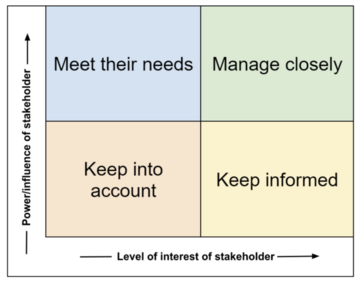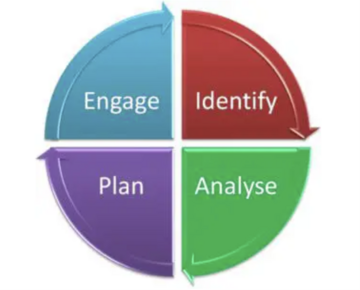Stakeholder mapping
(→Big idea) |
(→Application - Power/Interest Grid) |
||
| Line 72: | Line 72: | ||
=Application - Power/Interest Grid= | =Application - Power/Interest Grid= | ||
| + | In order to identify whom will be the projects stakeholders you can ask the questions, who has the knowlege, what do we need, who will get affected by the project? The different stakeholders such a project often is having is the once in Figure XX. | ||
| + | |||
| + | Downward stakeholders | ||
| + | |||
| + | Project group and project manager | ||
| + | |||
| + | Upward stakeholders | ||
| + | |||
| + | The once that finance the project, project owner | ||
| + | |||
| + | Outward stakeholders | ||
| + | |||
| + | Companies intern and extern. | ||
| + | Extern can be costumers supplier, business partners, interest organisations, authorities, competitors, the public and the press | ||
| + | Intern can be line managers, project managers for other projects, other employees and managers, union representatives, safety and cooperation committees | ||
'''Identification:''' | '''Identification:''' | ||
| Line 105: | Line 120: | ||
This plan shall make it clear how to communicate with the stakeholders, when to communicate and whom are responsible for the communication. | This plan shall make it clear how to communicate with the stakeholders, when to communicate and whom are responsible for the communication. | ||
Stakeholder mapping is a dynamic tool because stakeholders will sometimes chance during a project. Therefor you will have to reconsider the stakeholder analysis during your project. Figure 1 shows the cycle of stakeholder mapping, and it will first stop when the project has ended. | Stakeholder mapping is a dynamic tool because stakeholders will sometimes chance during a project. Therefor you will have to reconsider the stakeholder analysis during your project. Figure 1 shows the cycle of stakeholder mapping, and it will first stop when the project has ended. | ||
| − | |||
| − | |||
=Limitation= | =Limitation= | ||
Revision as of 15:58, 3 April 2023
Contents |
Abstract
This article is about the importance of making a stakeholder mapping before making changes in a working group for example in a company. The stakeholders can have influence or be able to affect the project. The influence or affect can occur before, under and after the execution of the project, and the stakeholders can have positive or negative influence on the project. Therefor it’s important that you handle the stakeholders in the right way when starting a project.
In this article you will be given the right tools for making a good Stakeholder Mapping. The Stakeholder Map consist of 4 steps: Identification, Categorization, Strategy for handling and Communication plan. [1]
The article will include following:
• What is Stakeholder mapping
• Whom are the Stakeholders
• The Idea behind the Method
• How to analyze
- Identification
- Categorization
- Strategy for handling
- Communication plan
After having read this article, the reader should be ready to make a Stakeholder Analysis specific to the project they are working on.
Big idea
Stakeholder mapping is a tool that helps you with identifying all stakeholders in any types of projects. It is important to make the stakeholder analysis in order to make sure you handle all the stakeholders in the right way. In all types of projects there will typically be many different stakeholders which means many different expectations to the outcome of the project.[2] Therefor it’s important to make a plan for how to communicate with all of the stakeholders in order to make them collaborate in the project.
There is some different types of methods to use for a stakeholder map. This is some of the most common once
Different types of stakeholder mapping models:1. Salience Model
2. Stakeholder Knowledge Base Chart
3. Power/Interest Grid
4. Power-Predictability Matrix
5. Stakeholder Relationship Mapping
6. Stakeholder Mapping Spreadsheets
This Wiki article will focus on the Power/Interest Grid. Unless other is specified this is the model the article is based on.
In general no matter which stakejolder mapping methos you decide to use there is some general tips.
Stakeholder Mapping Tips:[3]
1. Use multiple Mapping Methods
When you have to do a stakeholder mapping, it can be helpful to use more than only one method. In this way you will get a deeper understanding for your stakeholders.
2. Reference Stakeholder Maps Regularly
After you have made the Stakeholder Mapping its important that you keep bringing the map into discussion. In this way it will be possible to develop on the project strategies and make sure you handle the stakeholders correct.
3. Update Stakeholder Maps Regularly
Under a project your stakeholders might change and therefor it is important that you keep updating the stakeholder map to keep on track.
Application - Power/Interest Grid
In order to identify whom will be the projects stakeholders you can ask the questions, who has the knowlege, what do we need, who will get affected by the project? The different stakeholders such a project often is having is the once in Figure XX.
Downward stakeholders
Project group and project manager
Upward stakeholders
The once that finance the project, project owner
Outward stakeholders
Companies intern and extern. Extern can be costumers supplier, business partners, interest organisations, authorities, competitors, the public and the press Intern can be line managers, project managers for other projects, other employees and managers, union representatives, safety and cooperation committees
Identification:
The first step in generating a Stakeholder Map is to identify the project's stakeholders. This can be done by creating a brainstorm that inclueds all possible stakeholders. This tool is verry useful because a project can have many stakeholders and they can be both internal or external. Write down all persons or groups that will be affected in some way of the project. Don’t think too much about it you can always delete some stakeholders from the list afterwards, the worst that can happen is to forget some stakeholders.
Categorization:
With the list of all stakeholders you must now categorize the stakeholders into four different groups. Each of the four quadrants in the matrix indicates the difference in how to handle the stakeholders. [4] Take one stakeholder at the time and identify their influence on the project and their level of interest in the project.
Place the stakeholders in the Power/Interest Grid. Downunder is the different quadrants in the grid described.
High power / high interest – Manage closely, Stakeholders in this quadrant are the most important once for the project. They must be managed closely, regularly engage, and you have to manage their expectations. [5]
High power / low interest – Meet their needs, Stakeholders in this quadrant are very powerful but not verry interested in the project. Therefore, its important to meet their needs, keep them satisfied, and actively consult them.
Low power / low interest – Keep into account, Stakeholders in this quadrant don’t have much influence on the project. However, it’s important to monitor and provide information to them as needed.
Low power / high interest – Keep informed, Stakeholders in this quadrant do not have much influence but they have a high interest in the project. Therefor keep them informed and maintain their interest during the project.
Strategy for handling
When the stakeholders are categorized you have to make a plan for how to handle the stakeholders. This plan will include pros and cons, their affect on the project (positive or negative) and how to handle them. When you know how to handle the stakeholders its time to make a communication plan. This plan shall make it clear how to communicate with the stakeholders, when to communicate and whom are responsible for the communication. Stakeholder mapping is a dynamic tool because stakeholders will sometimes chance during a project. Therefor you will have to reconsider the stakeholder analysis during your project. Figure 1 shows the cycle of stakeholder mapping, and it will first stop when the project has ended.

